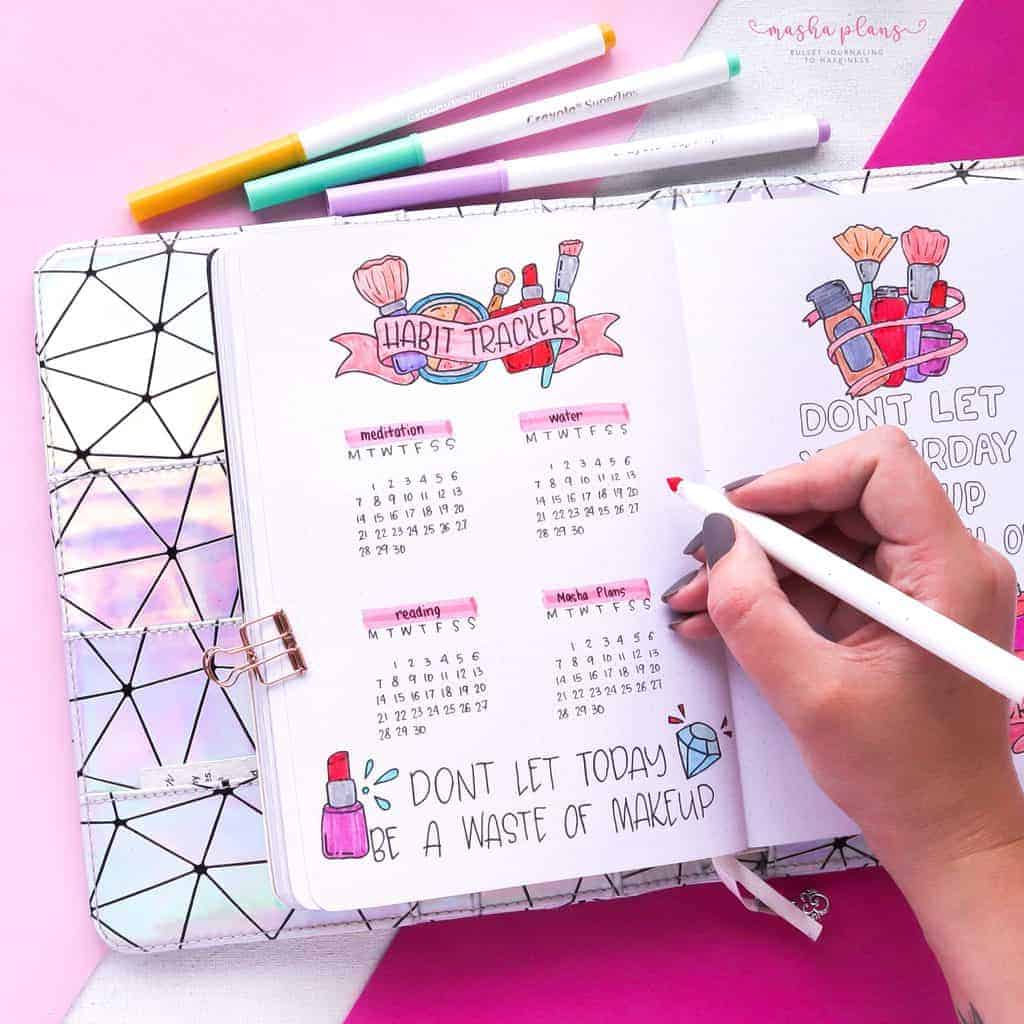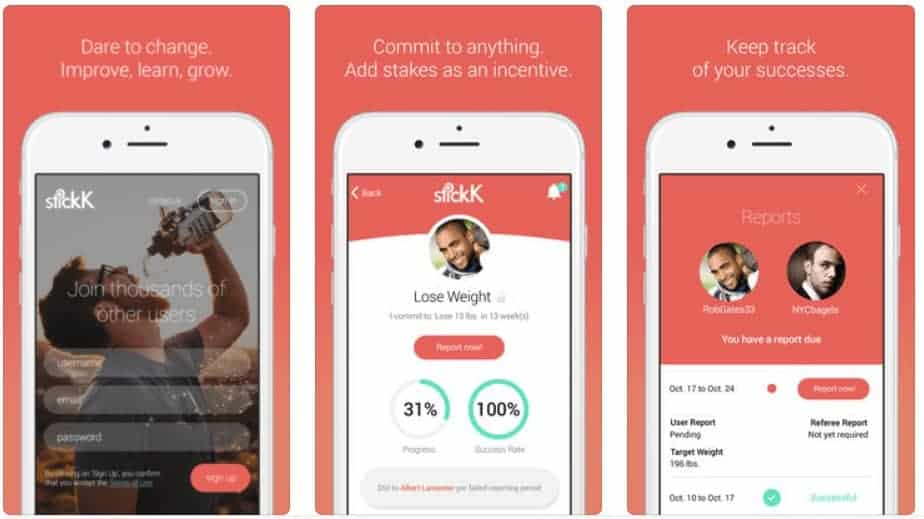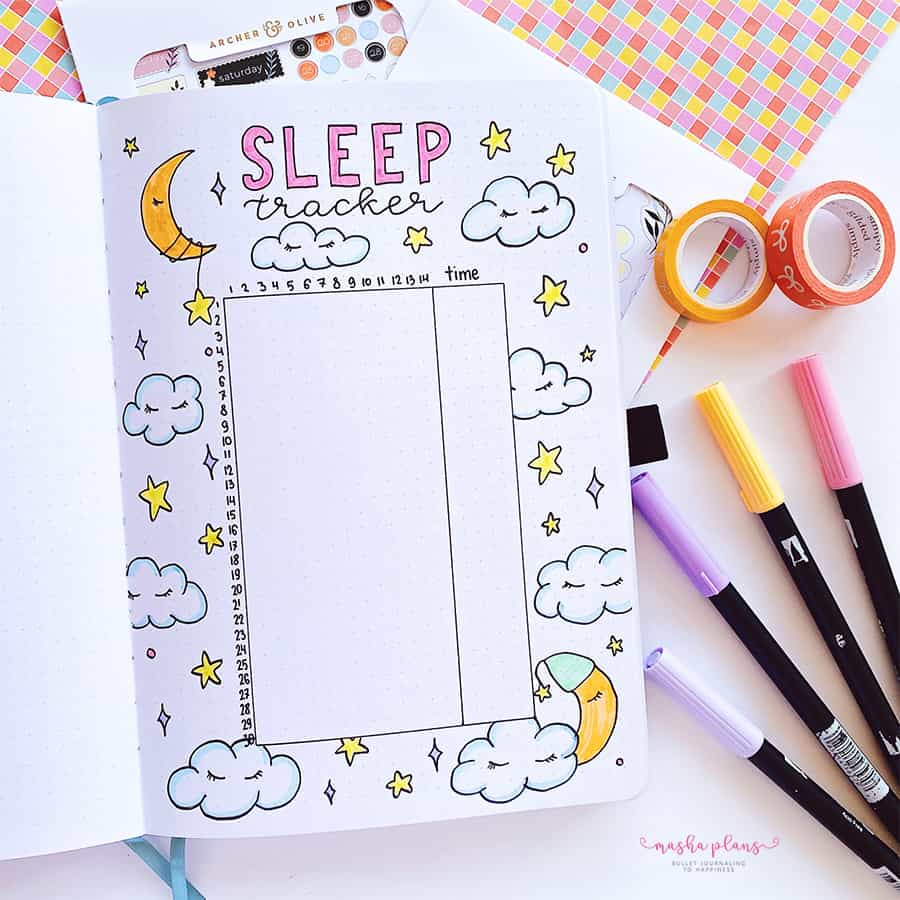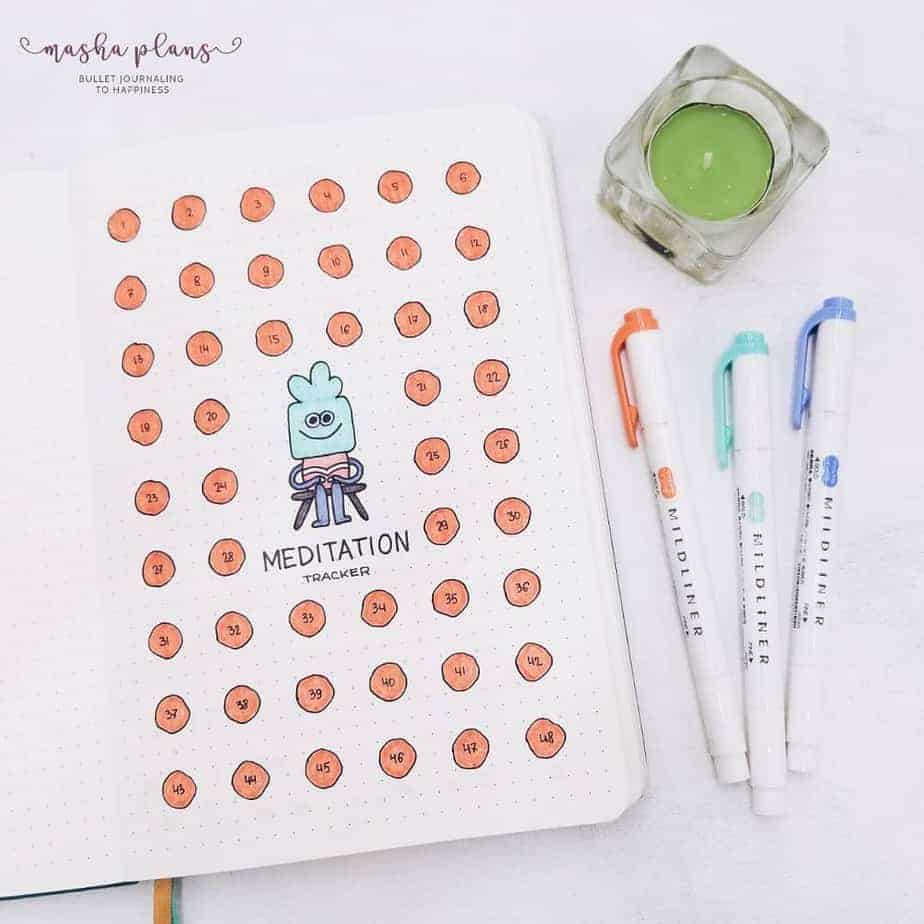The Ultimate Guide To Bullet Journal Habit Trackers
Habit trackers are a very popular Bullet Journal page idea, and for a good reason – they help to improve your lifestyle and achieve your goals.
This is why you should consider using them. Not sure how to start? Worry not!
In this post, I gathered all the information on what is a habit tracker, how to use one, and how it can help you to lead a better life.

The hardest but also probably the most impactful thing you can do for your self-development is to learn about your habits and work on making them better.
Once you know, yourself and the habits that keep you behind, you’ll have a clear path towards improving your life.
But how do you do that?
If you’re a Bullet Journal fan, the answer is easy – by using a habit tracker.
This post may contain affiliate links. They will be of no extra expense for you, but I receive a small commission. Please see my Disclosure for more details. Thank you for supporting Masha Plans!
What Is A Bullet Journal Habit Tracker
A habit tracker is… well… a way to track your habits.
Duh.
Basically, instead of writing down the same task every day (for example – go do some yoga!), you already have it all written on a separate page and you just have to tick it if you completed the task, which in turn helps you to be more aware of your habits and behaviors.
It’s usually a big double-entry table including the dates and the habits you want to track. You can color or simply tick off the days when you complete the habit.
Of course, the Bullet Journal community is full of talented people who found new and exciting ways to track their habits. But if you’re just starting, I’d advise you to use the basic format first.
A habit tracker is probably the best way to become more accountable to yourself and also to either break a bad habit or create a new positive one.
Let’s take a look at some habit tracker benefits.
Why You Should Use A Habit Tracker
I’ve been using habit trackers in my Bullet Journal every single month, so let me share my experience.

First and foremost – habit trackers are a great motivation to do things. It sounds silly, but at the end of the day, getting to color that little square in your tracker really motivates you to do it.
Here is the secret: Our brains are hard-wired into wanting to ALWAYS complete things. That’s why puzzles are so addictive. So having an empty square at the end of the day, will basically make your brain motivate you to try and follow your habits. It’s science!
Second – it helps to encourage you! Let’s say you’ve been working out every day this week, but when the next Monday comes, you don’t really feel like doing it. Take a look at how pretty your tracker looks with all these squares filled! Look at how far you’ve already come. For me – it’s a great encouragement to not give up.
Third – you can see your patterns. This is very important! Some habits just don’t stick. With a habit tracker, you’ll be able to see why, and change your schedule accordingly.
Fourth – it helps you establish a daily routine. I said it once, and I’ll say it a million times – having routines is very important when you’re working on increasing your productivity. And having a habit tracker makes sure that every day you stick to your usual routines
And finally – a habit tracker can help you achieve your goals. When you set your goals, don’t just think about what you gotta do; think of what kind of person you want to become. Basically – what kind of habits you should have to get one step closer to your ideal self.
For example, if (to be honest there is no if there, that’s really something I want to do) I want to become a full-time blogger, I need to make sure I write at least a little bit every day. The habit tracker is helping me to stay on track with that, developing a habit and a skill, and getting me closer to my goals!
If you want to start using one right away, check out the Resources Vault for several free printable Bullet Journal habit trackers.
If you’re not part of Planning Mashers yet, join us in the signup form at the end of the post. You’ll get access to a wonderful community, useful newsletters, and TONS of free printables for your Bullet Journal.

Who Should Be Using Habit Trackers
Just because this is something many people use, it doesn’t mean it will be a good fit for you. That being said, I still think you might want to give it a try.
Habit trackers are for you if:
- Things you want to accomplish take more than just one day
- You’re looking to work on your personal development
If you’re completely happy with your life and can’t think of anything you’d like to change or improve, then maybe habit tracking isn’t really for you.
However, if you feel that way, you most likely need to reevaluate your current situation because there are always areas in our lives with room for improvement.
Habit Tracker Types
There are different ways to set up your habit tracker, and my advice would be to try them all and see which one works best for you.
There are basically three types of trackers.
Yearly Habit Tracker
These are great because you get to see your path throughout the whole year, and it’s very encouraging to see your progress.
However this format has a con as well – in time, you might change the habits you track or find that some habits are not really worth tracking anymore.

This page is a year in pixels, so it actually is a moos tracker, but you really can make it anything you want.
I know some people are doing this for their workouts for example.

For more ideas, you can check my post with Bullet Journal Yearly Tracker Ideas.
Monthly Habit Tracker
The second type of habit tracker is a monthly tracker. This is the format I like the most.
You will see the overview of the month and understand what worked and what didn’t, so you can make changes accordingly for the next month.

Weekly Habit Tracker
I use those as well, but personally just for some weekly chores.
But I do know that a lot of people find that they follow their habits more if they have the tracker right there in the weekly spread. So give them a try, maybe they’ll be the best option for you as well.

Daily Habit Trackers
These are convenient because you can fill out your tracker right there in your daily spread.
I personally use them for some simple things like water intake – something I have to do daily but don’t necessarily need to see the patterns. More of a reminder if you will.

How To Set Up a Habit Tracker
You don’t need much to set up your habit tracker – a fineliner and some colors (like my favorite Zebra Mildliners) would be just enough.
If you want to create some cute circle trackers, you definitely will need a Helix Circle Ruler. Or if you want you can invest in my favorite set of stencils, which includes a stencil for usual table tracker, as well as the one for circle trackers (or a circle monthly log).
Here are a few ways you can set up your habit tracker.
Mini Habit Trackers
Mini habit trackers are great if you want to track your habits daily or weekly.
Plus, you can completely customize it to whatever theme you have that month.

I also like kind of make them in a style similar to the habit I’m tracking.
Like medicine would be a set of pills, reading would be a set of books, and so on. Just something small to add a bit more creativity.

Calendar Habit Trackers
My favorite way to set up a habit tracker is by creating little calendars for each habit.
I love how clean it looks and how easy it is to see how you’re doing on each habit.

This one is from my November Coffee Themed setup, I really had a lot of fun with it.
Ironically, I actually spilled some soup on this page! Now covered with a brown coffee blotch and white gel pen.

And here are just a few more ideas on how you can style your calendar-type habit trackers.
This is probably the most popular format and when I started Bullet Journaling, this is the format I began with.
It’s really convenient when you have a lot of things to track.

You can create it on one spread, so you’ll need to turn in your journal every time you fill out your tracker.
Or you can create one huge habit tracker on two pages.

Vertical Habit Tracker
Another great format if you want to track quite a lot of habits but want to see how you do every day on each habit.
That way, you can estimate your day-by-day, not habit-by-habit.

Vertical formats are super fun; the only thing I’d recommend here is to use icons for your habits.
I use icons all the time myself, so it’s very easy for me to understand them, but if you don’t, it might take some time for you to get used to what they mean.
But I really think you should learn to use icons in your Bullet Journal, it’s very convenient and saves time and space.

Circle Tracker
These are so so cute! Ever since I started Bullet Journaling I’ve been in love with circle tracker and dying to try it.
They also look pretty neat, even if you’re tracking several habits at the same time.
It might be a bit difficult to set it up though, personally, I always miscalculate how many sections I need. So pay extra attention to it when you’re setting up yours.

If you’re into it, I definitely recommend you to get circle stencils, like these ones I use.
They definitely will save you a lot of time and make your circle trackers look so much neater.

Square Version of The Circle Habit Tracker
If you like the circle tracker format, but can’t be bothered to draw it, go for the corners.
It’s much easier to set up, and it still looks interesting enough.

Doodly Habit Tracker
This type of habit tracker is super fun, but it does take extra effort because it implies that you need to repeat a doodle as many times as there are days in the month.
The idea is that you draw a doodle and assign a habit to each part of it. Once you complete the habit during the day, just color that part of the doodle

You can check out my video with 9 different ways to set up your Bullet Journal Habit Tracker for more ideas.
As a beginner, I recommend you go with something very simple and basic. But if you’re looking to explore – just try them all and see what works best for you!
Habit Tracking Apps
Using your habit trackers in your Bullet Journal is great, but sometimes, it’s more convenient to go digital with this.
After all, using your phone allows you to quickly mark a habit as completed whenever you are, and you might not have your journal with you at all times.
If this sounds like something better fitting for you, here are a few apps that you could use.
Habitica

This app brought the spirit of RPG games to the process of developing new habits. Each task you complete will level up your avatar, creating an extra incentive to follow through.
The app is available on both iOS and Android.
Productive Habit Tracker

Simple but well-designed app. It will keep you on track with your habits. It allows you to see the progress chart of your habit development, and it can also send you reminders on your Apple Watch.
This app, however, is only available on iOS.
HabitsShare

This habit tracking app is unique because it has a social aspect to it. Within the app, you can connect with your friends and message each other. This is definitely helpful to stay more motivated and building an extra level of accountability.
The app is available on both iOS and Android.
Streaks

This app allows you to track up to 12 habits and encourages you to create consecutive day streaks for each of them.
Moreover, it allows you to synchronize with the Health app, creating shortcuts and sending reminders to your Apple Watch.
This app is only available on iOS.
StickK

This app was created by economists from Yale University and based on tons of research to ensure you follow through with your intentions.
When signing up, you create a contract with the app that you’ll achieve the goal you set for yourself. You can also include your friends and family members to check up on you and make sure you’re on the right track.
Available on both iOS and Android.
What To Track In Your Habit Tracker
I would say there are a few categories of what you can add to your habit tracker.
- Things you want to do on a more regular basis (going to bed at 10 pm, I mean you!).
- Things you just want to see when was the last time you did them – how often you went for a walk? When was the last time you did that hair mask?
- Actual new habits you’re working on.
As you can guess, this can create a very long list and eventually turn filling out the tracker into a chore.
We don’t want that.
So try not to overdo it, and don’t track everything. Otherwise, you just won’t get any positive results.
My solution to the problem is to use different kinds of trackers. I have an important monthly habit tracker, but for small tasks, like cleaning chores and beauty treatments, I use a weekly tracker.
30 Things To Track In Your Bullet Journal
To give you some ideas to start with, see below 30 different things you can track:
- Water consumption
- Exercise
- Vitamins Intake
- Sleep before a certain time
- Early wake up
- Sleeping for 8 hours
- Meditation
- Sexy times :D
- No junk food
- Affirmations
- Reading
- No money spent
- Journaling
- Creative time
- Miracle Morning
- 10 000 Steps
- Make bed
- Laundry
- Water plants
- No sugar
- Vacuum
- “Me” time
- Talk to family/friends
- Random act of kindness
- Ironing
- Personal development
- Study time
- Beauty routine
- Period
- Bible study

Here is an annual cleaning tracker. I really think if cleaning becomes a habit and something you do little by little every day, it won’t be such a consuming chore.
Plus, this tracker kind of makes cleaning a bit more fun, wouldn’t you agree?

This is my version of the monthly workout tracker.
It’s pretty simple – each day you do some kind of a workout and color the box.

The sleep tracker is really an important thing, especially if you’re working on your mental health.
Sleep is the most important thing to help you with mental and physical health, so if it’s something you’re struggling with – a sleep tracker can be an answer.
A cool thing to add here might be the column about how you’re feeling in the morning, so you know what kind of sleep works best for you.

This is a mix of a mood tracker and a habit tracker.
This looks super cute, but it really took way too much time to set it up, and it definitely can be confusing.

Filling out this tracker was such an amazing achievement for me, so I had to include it here as well.
Seeing this tracker filling out really helped me to keep meditating at least a little bit every day and keep the streak. Of course, it all ended up being very beneficial for my mental health and general well-being.
If you’re looking for more ideas, check out these posts:
Tips for Succeeding With Your Habits
Creating new habits is hard. Even though at the beginning you’re full of enthusiasm and ready to roll, as time goes by, it becomes harder and harder until you skip one day, then another, and then you just forget about the habit altogether.
This happened to me far too often, so I want to share with you some tips on working on new habits. I’m sure these will help you to succeed with your intentions.
- Start small. There are 190+ ideas on what you can track in your habit trackers, but using all of them at once is absolutely counterproductive. The more new habits you have to track the more likely you’ll slack on those. So start from just a few, but pay extra attention to making sure you do them every day.
- Pick the habits correctly. When you start researching good habits, there are so many available, and it’s easy to want to start doing them all. However, to make the habit stick, you really need to understand why exactly you want this in your life. So when picking the habits, be specific on your reasoning. For example, instead of “I want to drink more water because it’s good for me”, think about why exactly and formulate it as “I want to drink more water because it will make my skin look better.” That makes you much more motivated to follow through, doesn’t it
- Pick the tracking system that works for you. We already talked about it before, don’t choose something because it’s what your friend is using. Maybe you’d be better off using a habit tracker in your Bullet Journal, or maybe a much simpler habit-tracking app. Experiment and see what way of tracking works best for you.
- Use a functional design. If you track your habits in your Bullet Journal, be sure not to get seduced by elaborate habit tracker designs. They all look fantastic and I totally get the desire to create something just as beautiful. But with habit trackers, the simpler the better, believe me. The easier it is to fill the tracker and see your progress, the more likely you’ll be to stick to your habit and stay motivated to go on.
- Track your habits on a smaller scale. Everything is much easier to achieve if you scale it down to smaller sections. A year of workouts sounds pretty scary, but if you track it week by week, it’ll be easier to stick with it. Give a try to weekly trackers instead of monthly or yearly ones, especially if it’s a new and very drastic habit change.
- Prepare for possible obstacles. Like when it’s raining, I really don’t feel like going to the gym. Or if something urgent happened during the day and I had no time to write a new blog post. Create systems to deal with these. If you already have a plan on what to do, you’re more likely to stick with the habit instead of just dropping it for the day. For example, if it’s raining and I don’t want to go to the gym I’ll just do some yoga at home.
- Create a little reward system. It really doesn’t have to be something huge, but little rewards will definitely increase your motivation. Maybe if you manage to stick with your habits for a month, you’ll get yourself a Tombow Dual Brush pen (stationery works the best for me always!). This will add fun and excitement to building a new habit!
What If You Fail?
There is no success without failure, and the same goes for developing new habits. It’s absolutely fine to fail a few times as long as you learn from it and keep on going.
It is, however, pretty difficult to deal with it, so here are some of my tips for dealing with it.
- Don’t get discouraged. We’re all human, and you can’t expect perfection from yourself. Life happens, and a lot of factors that you can’t control influence your habits. Even if it was within your control, you’re still human. So don’t despair and drop everything; just forgive yourself and get a new start date for your next streak.
- Change your habits. Sometimes we fail because habits are unrealistic, or we aren’t sure about our motivation. Or maybe it’s just something we don’t really want. Take a good look at the habit and analyze why you failed. Maybe it’s not for you, and it’s time to change up the habit to something different or maybe smaller on the scale.
- Cheat days. It’s fine to skip some days. Divide your habits by streak intervals and schedule a cheat day in between. This will make it so much easier to stick with the habit. I know in a habit tracker, an empty space might be extremely bothersome, so just blackout your cheat days, or choose a different color for them.
- Take some time off. It’s possible that at this point in your life, developing new habits is just not a good idea. Maybe you need to concentrate on something different at the moment. Don’t worry; take a break and go back to the habits when it’s a better time for you.
- Try different tracking methods. Maybe circle trackers just don’t work for you, and that’s the reason why you failed. Try a different way! Maybe you just need a new layout to get inspired and get back on track.
Free Bullet Journal Printables
Want to start tracking your habits right away? Try using some printables.
There are already many habit trackers available in the Resources Vault.

If you don’t have access yet, you can always sign up in the form below.
Once you confirm your subscription, you’ll get the password to get 50+ free Bullet Journal printables, stickers, and worksheets to use right away.
What do you track in your Bullet Journal? And what format works best for you? Let me know in the comments section below.
Hope this post was useful; if you find it so, please share! If you enjoy my content and want to show your appreciation, please consider supporting me with a cup of coffee.
And remember: Keep Bullet Journaling, and Don’t Be A Blob.




